
New Delhi, Aug 27 (IANS) When it comes to purchasing power parity (PPP), India is likely to become the world’s second-largest economy in PPP terms by 2038, a new report showed on Wednesday.
PPP is effectively the ratio of the price of a market basket at one location divided by the price of the basket of goods at a different location.
According to the EY report, based on IMF projections, India’s economy could reach $20.7 trillion (PPP terms) by 2030, better placed than the US, China, Germany, and Japan.
Among the largest economies, India stands out with a median age of 28.8 years in 2025 and the second-highest savings rate.
The government debt-to-GDP ratio is projected to decline from 81.3 per cent in 2024 to 75.8 per cent by 2030.
While China leads in overall size with a projected $42.2 trillion economy (PPP) by 2030, its ageing population and rising debt are challenges, according to the report.
The US remains strong but faces high debt levels exceeding 120 per cent of GDP and slower growth rates.
Germany and Japan, though advanced, are constrained by high median ages and heavy reliance on global trade, according to the EY report.
On the other hand, India has youthful demographics, rising domestic demand, and a sustainable fiscal outlook.
According to DK Srivastava, Chief Policy Advisor, EY India, India’s comparative strengths, its young and skilled workforce, robust saving and investment rates, and relatively sustainable debt profile will help sustain high growth even in a volatile global environment.
“By building resilience and advancing capabilities in critical technologies, India is well-placed to move closer to its Viksit Bharat aspirations by 2047,” he noted.
India is also projected to become the third-largest economy in market exchange rate terms by 2028, overtaking Germany.
The country’s trajectory is reinforced not just by demographics but also by structural reforms and resilient fundamentals.
–IANS
na/vd




